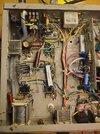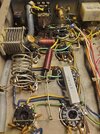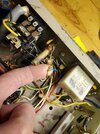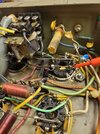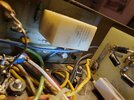The plate of the 8950 tube is not supposed to "cherry", or give off any light from the surface, not even dull red.
The 8950 has an internal jumper joining pin 5 to pin 9. This is the control-grid pin where negative bias is applied. Either pin 5 or 9 works for that tube.
The 6LB6 has only pin 5 connected to the control grid. A jumper wire across each tube socket from pin 5 to pin 9 would make the socket work for either tube type. Sounds to me as if the connection has been made only to pin 9 on one or more of the tube sockets.
If that jumper wire is already there, probe pin 5 and make sure you have around 16 Volts DC, negative polarity. if you don't it's time to find out why.
73
The 8950 has an internal jumper joining pin 5 to pin 9. This is the control-grid pin where negative bias is applied. Either pin 5 or 9 works for that tube.
The 6LB6 has only pin 5 connected to the control grid. A jumper wire across each tube socket from pin 5 to pin 9 would make the socket work for either tube type. Sounds to me as if the connection has been made only to pin 9 on one or more of the tube sockets.
If that jumper wire is already there, probe pin 5 and make sure you have around 16 Volts DC, negative polarity. if you don't it's time to find out why.
73

